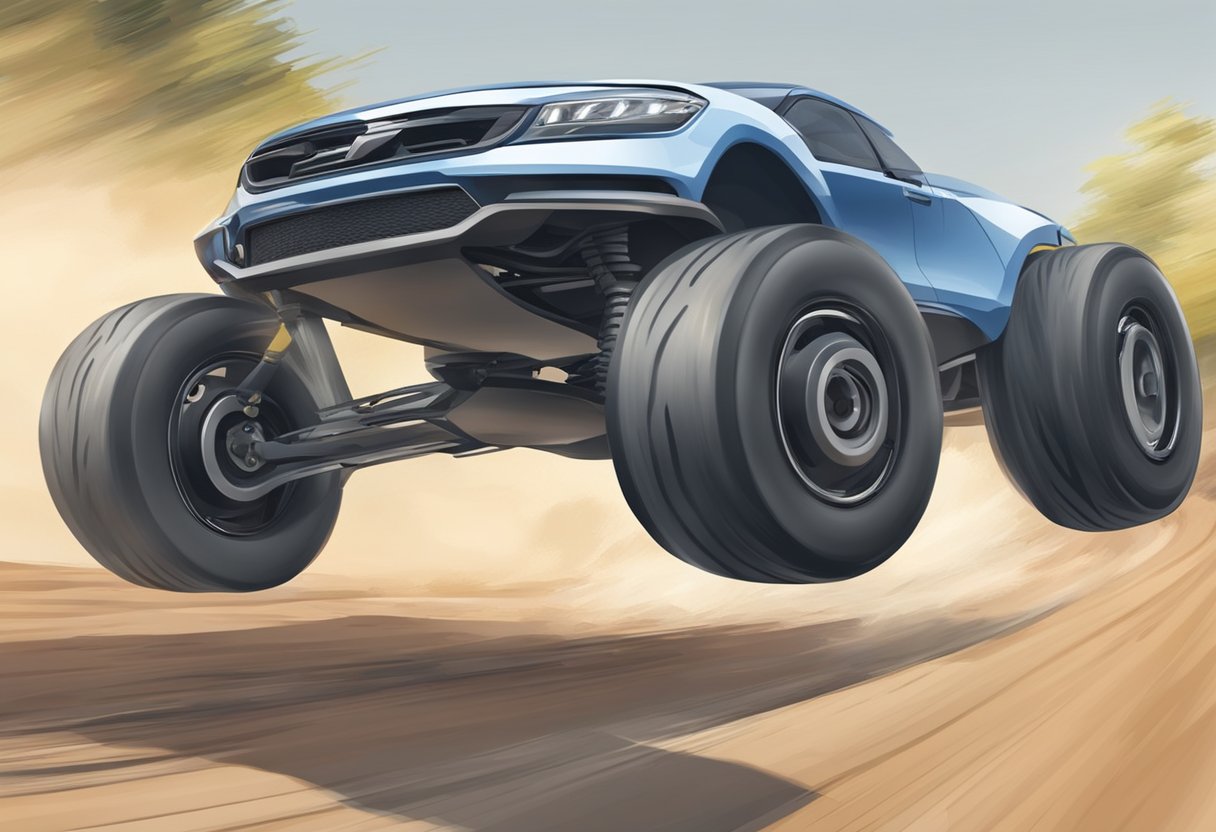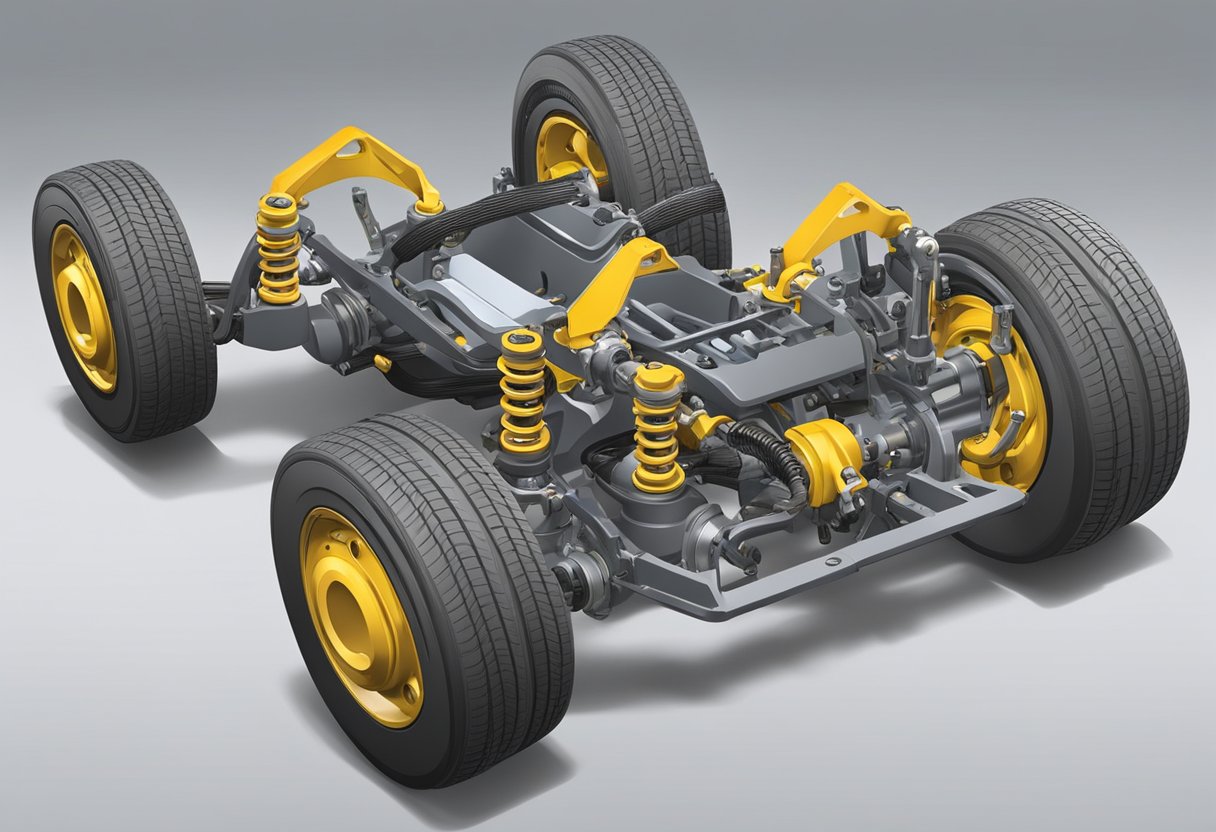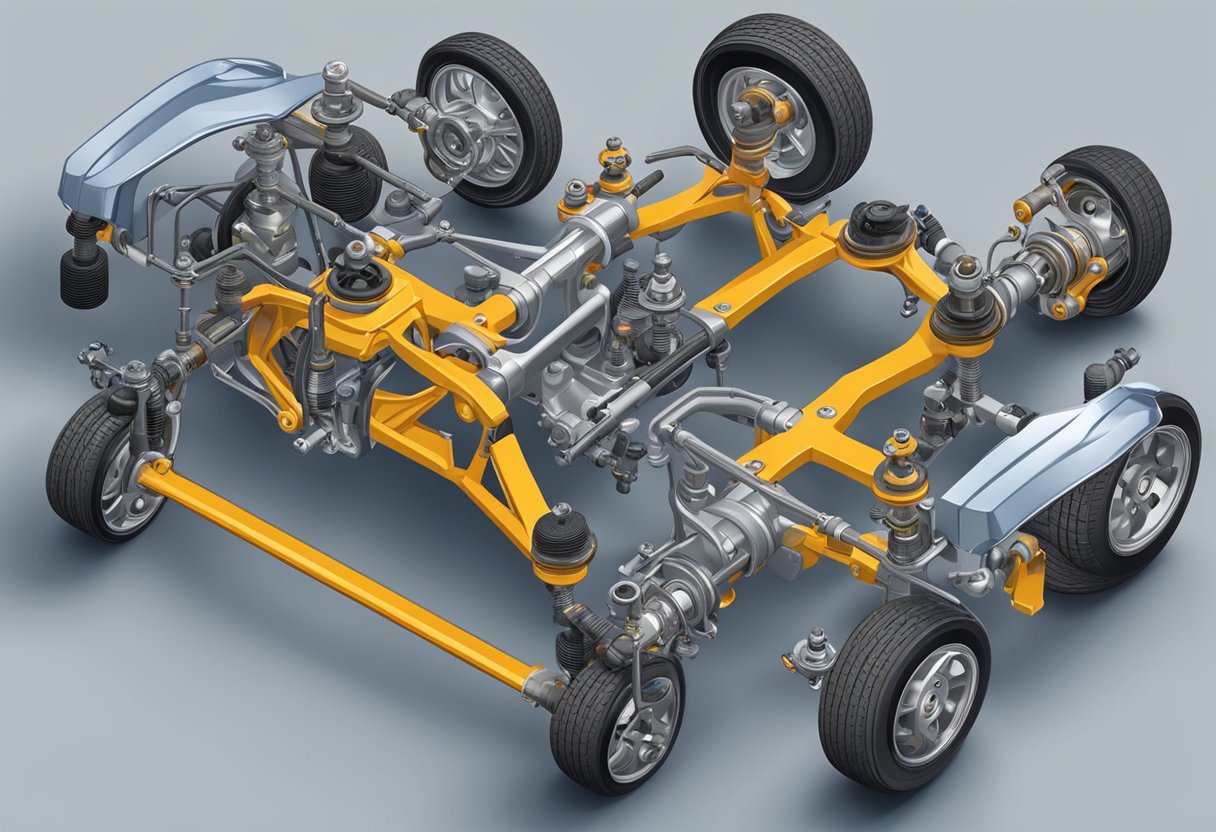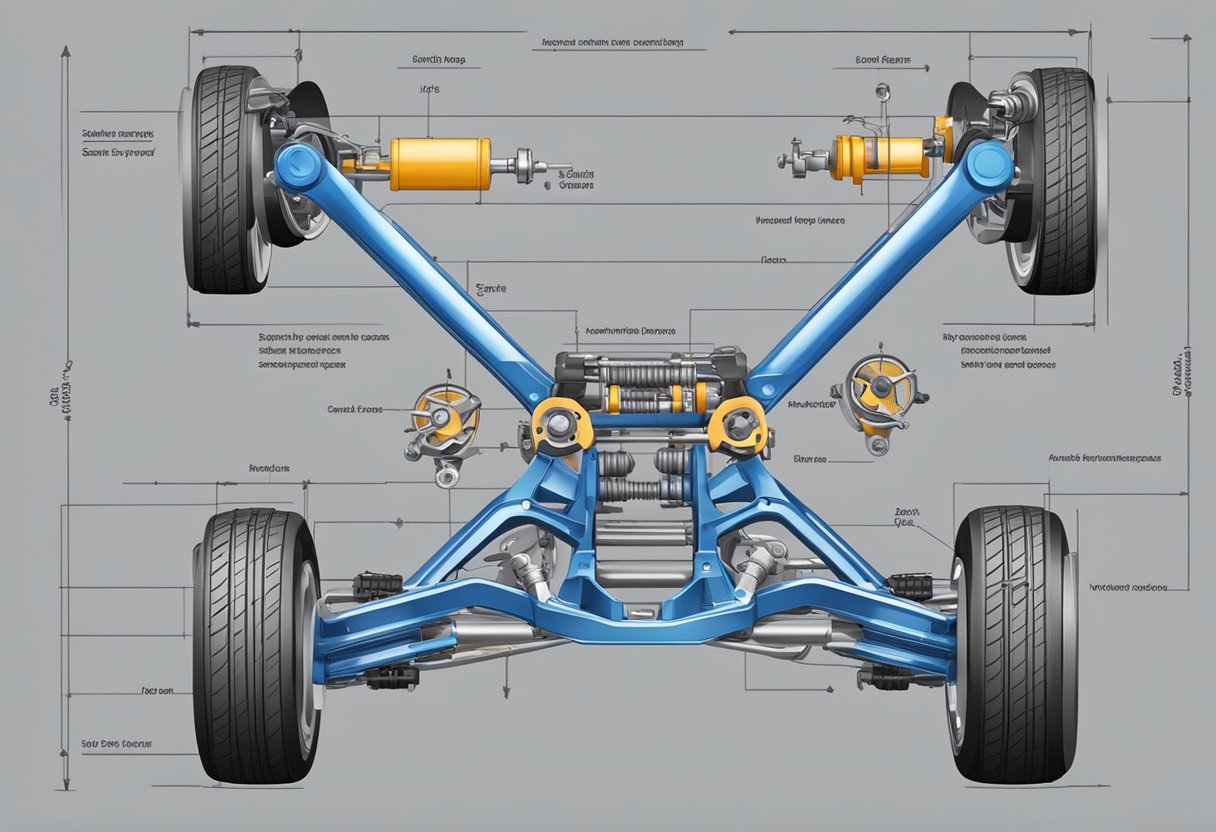If you’re like most drivers, you probably don’t spend much time thinking about your car’s suspension system. However, this crucial component is responsible for keeping your vehicle stable and balanced on the road. The front-end suspension, in particular, plays a critical role in ensuring your car’s handling and safety.
Understanding how your front-end suspension works can help you identify potential problems and keep your vehicle running smoothly. In this article, we’ll take a closer look at the front-end suspension system and how it affects your car’s stability. From the basic components to the way it interacts with other systems, we’ll explore everything you need to know to get a better understanding of your car’s suspension.
Fundamentals of Front-End Suspension
Understanding how your car’s front-end suspension works is essential for maintaining stability and control while driving. The suspension system is responsible for absorbing shock and providing a smooth ride while ensuring that your car’s wheels remain in contact with the road. In this section, we will explore the components of suspension systems and the types of front-end suspensions.
Components of Suspension Systems
A typical front-end suspension system consists of several components that work together to provide a smooth and stable ride. These components include:
-
Springs: Springs are the most fundamental component of any suspension system. They absorb shock and provide the necessary force to keep your car’s wheels in contact with the road. Springs come in various types, including coil springs, leaf springs, and torsion bars.
-
Shock Absorbers: Shock absorbers work in conjunction with springs to dampen the energy transferred from the road to your car’s chassis. They absorb the energy generated by the springs and convert it into heat, reducing the amount of bouncing and swaying of your car’s body.
-
Struts: Struts serve a similar function to shock absorbers but are integrated into the suspension system. They provide structural support to the suspension system and help maintain the alignment of the wheels.
-
Control Arms: Control arms connect the suspension system to the car’s chassis and provide the necessary support for the wheels. They help maintain the alignment of the wheels and allow them to move up and down in response to road conditions.
Types of Front-End Suspensions
There are two primary types of front-end suspensions: independent and dependent suspensions.
-
Independent Suspensions: Independent suspensions allow each wheel to move up and down independently of the other wheels. This type of suspension provides a smoother ride and better handling, particularly on uneven terrain.
-
Dependent Suspensions: Dependent suspensions, also known as solid axle suspensions, connect both wheels on an axle. This type of suspension is less expensive and easier to maintain, but it provides a rougher ride and less precise handling.
Understanding the fundamentals of front-end suspension is crucial for maintaining your car’s stability and control. By knowing how the suspension system works, you can diagnose problems and make informed decisions about repairs and upgrades.
How Front-End Suspensions Maintain Stability
Your car’s front-end suspension is responsible for maintaining stability while driving. It is composed of several components that work together to ensure your car handles correctly. The two primary components of the front-end suspension are the shock absorbers and the steering and alignment system.
Shock Absorption Mechanism
The shock absorbers are designed to dampen the vibrations caused by driving on uneven surfaces. They are typically made up of a piston and a cylinder that contain hydraulic fluid. When your car hits a bump, the piston compresses the fluid, which absorbs the shock and prevents it from being transmitted to the rest of the car.
Shock absorbers are critical to maintaining stability while driving. If they become worn or damaged, your car’s handling can be compromised, making it more difficult to control. Regular maintenance and inspection of your car’s shock absorbers can help prevent this from happening.
Steering and Alignment
The steering and alignment system is responsible for keeping your car moving in a straight line. It is composed of several components, including the steering wheel, steering column, and tie rods. When you turn the steering wheel, it sends a signal to the tie rods, which turn the wheels and change the direction of the car.
Alignment is also critical to maintaining stability while driving. If your car’s wheels are misaligned, it can cause your car to pull to one side or the other, making it difficult to control. Regular alignment checks and adjustments can help prevent this from happening.
In summary, the front-end suspension of your car is responsible for maintaining stability while driving. The shock absorbers and steering and alignment system work together to ensure your car handles correctly. Regular maintenance and inspection of these components can help prevent problems and ensure your car is safe to drive.
What’s the Importance of a Car’s Suspension System for a Smooth Ride?
The rear suspension replacement cost can vary, but the importance of a car’s suspension system for a smooth ride cannot be overlooked. A well-maintained suspension helps absorb bumps, improve vehicle handling, and ensures a comfortable journey for both the driver and passengers.
Common Front-End Suspension Designs
There are several types of front-end suspension designs, each with its own unique characteristics. Understanding the differences between them can help you make informed decisions about your car’s stability system. In this section, we will explore two of the most common front-end suspension designs: MacPherson Strut and Double Wishbone.
MacPherson Strut
The MacPherson strut is a popular front-end suspension design that has been used in many cars for decades. It consists of a single shock absorber that is mounted to the lower control arm and the body of the car. The upper part of the strut is attached to the body of the car, while the lower part is attached to the steering knuckle.
One of the advantages of the MacPherson strut is its simplicity. It is easy to manufacture and install, which makes it a cost-effective option. It also takes up less space than other suspension designs, which is an important consideration in smaller cars.
Double Wishbone
The Double Wishbone suspension design is another popular choice for front-end suspensions. It consists of two wishbone-shaped arms that are attached to the steering knuckle and the body of the car. The shock absorber is mounted between the two arms.
One of the advantages of the Double Wishbone suspension is its ability to provide a smooth ride. It allows for more precise control of the wheel’s movement, which can result in better handling and stability. It is also a more complex design, which can make it more expensive to manufacture and install.
In summary, the MacPherson strut and Double Wishbone are two common front-end suspension designs that you may encounter in your car. Each has its own unique characteristics and advantages, so it is important to understand the differences between them when making decisions about your car’s stability system.
How Can Body Control Unit Failures Affect the Front-End Suspension of a Car?
Body control unit failures can lead to various symptoms that affect the front-end suspension of a car. These symptoms may include erratic behavior of the front-end suspension, uneven tire wear, and difficulty steering. It is important to address body control unit failures symptoms promptly to prevent further damage to the vehicle’s suspension system.
Suspension System Maintenance
Maintaining your car’s suspension system is crucial for ensuring a smooth and safe ride. Regular inspection and care can help you identify and address any issues before they become major problems. In this section, we’ll discuss some key aspects of suspension system maintenance.
Regular Inspection and Care
One of the most important things you can do to maintain your suspension system is to perform regular inspections. This can include checking for any signs of wear or damage, as well as ensuring that all components are properly lubricated.
Here are some key areas to focus on during your inspections:
-
Shock absorbers: Check for any leaks, damage, or signs of wear. If you notice any issues, it’s important to get them addressed as soon as possible.
-
Springs: Look for any signs of damage or wear, such as cracks or sagging. If you notice any issues, it may be time to replace your springs.
-
Bushings: Inspect your bushings for any signs of wear or damage. If they’re worn out, they can cause your car to handle poorly and may even lead to suspension failure.
-
Tires: Make sure your tires are properly inflated and have adequate tread depth. Worn or underinflated tires can cause your suspension system to work harder than it needs to.
Troubleshooting Common Issues
Even with regular maintenance, you may encounter some common suspension system issues. Here are a few things to look out for:
-
Uneven tire wear: If you notice that your tires are wearing unevenly, it could be a sign of suspension problems. This could be caused by issues with your shocks, springs, or alignment.
-
Bouncing or bottoming out: If your car is bouncing excessively or bottoming out over bumps, it could be a sign of worn out shocks or springs.
-
Pulling or drifting: If your car is pulling to one side or drifting while driving, it could be a sign of alignment issues or worn out suspension components.
By keeping an eye on your suspension system and addressing any issues as soon as they arise, you can help ensure that your car stays safe and reliable on the road.
Advancements in Suspension Technology
Advancements in suspension technology have led to significant improvements in the performance, safety, and comfort of vehicles. In the past, vehicles used mechanical suspensions that relied on springs, shocks, and other components to absorb bumps and maintain stability. However, with the advent of electronic and adaptive suspension systems, cars are now equipped with more sophisticated systems that can adjust to different driving conditions and driver preferences.
Electronic Stability Control
Electronic stability control (ESC) is a safety feature that helps prevent accidents by keeping the vehicle stable during sudden maneuvers, such as swerving or braking. ESC uses sensors to monitor the vehicle’s speed, steering angle, and other parameters to detect any loss of control. If the system detects a potential skid or slide, it will automatically apply the brakes and adjust the engine power to help the driver regain control.
ESC has become a standard feature on most new vehicles and has been shown to reduce the risk of accidents and fatalities. According to the National Highway Traffic Safety Administration (NHTSA), ESC reduces the risk of fatal single-vehicle crashes by 56 percent and fatal multiple-vehicle crashes by 32 percent.
Adaptive Suspension Systems
Adaptive suspension systems use sensors and computer algorithms to adjust the suspension settings based on driving conditions and driver preferences. These systems can adjust the stiffness of the suspension, the ride height, and other parameters to optimize handling, comfort, and performance.
Adaptive suspension systems can improve the handling of the vehicle by reducing body roll and improving grip. They can also improve the ride quality by reducing the impact of bumps and uneven road surfaces. Additionally, some systems allow the driver to select different modes, such as sport or comfort, to adjust the suspension settings to their liking.
Overall, advancements in suspension technology have made vehicles safer, more comfortable, and more enjoyable to drive. Whether you’re navigating a winding road or cruising on the highway, a well-designed suspension system can make all the difference in your driving experience.
As an Amazon Associate we earn from qualifying purchases.















